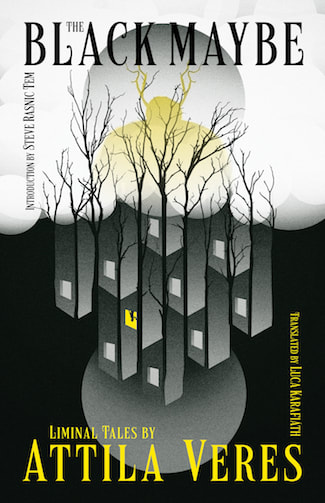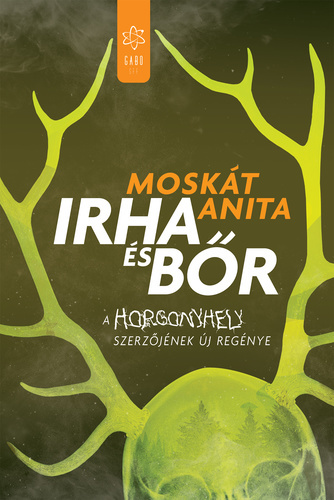


Hungarian Speculative Fiction: The Three Pillars
by Austin Wagner
When it comes to writing about Hungarian speculative fiction for an English-speaking audience, an enormous problem rears its ugly head before the first sentence can even be typed out – namely that very little speculative fiction written in the last fifty years has been translated from Hungarian into English. You have some classics from the early and mid-20th century that have made it into translation, sure – but just as British fantasy, Polish science fiction, and American horror didn’t start and end with Tolkien, Lem, and Lovecraft, neither did Hungarian speculative fiction die before the turn of the century. If you believe, like I do, that one of the greatest strengths of SFF is to comment on, critique, and question the ills of society, to shine a light (however eldritch) on the plight of those suffering the most, shouldn’t we be fighting tooth and nail to get more contemporary SFF into English? I certainly think so.
So, teeth filed and nails sharpened, I’d like to introduce three Hungarian authors today – not only are they three of my personal favorites, they are also inarguably three of the pillars holding up the world of contemporary Hungarian speculative fiction. And as fate would have it, they each occupy a different corner of the SFF tent: Botond Markovics with science fiction, Anita Moskát with fantasy, and Attila Veres with horror.
SCIENCE FICTION – BOTOND MARKOVICS
In the world of science fiction, Botond Markovics (who previously wrote under the penname Brandon Hackett) will be the first on nearly anyone’s list. Though here it’s especially important to reiterate that we’re looking at contemporary science fiction; there is a strong science fiction tradition in Hungary, but its icons – Péter Zsoldos, István Nemere, or the Galaktika magazine – were mostly in their heyday throughout the ’60s, ’70s, and ’80s. When it comes to sci-fi that has appeared post-2000, multi-award-winning Markovics is largely unrivaled in consistency and success.
Markovics’ work is in many ways classical space opera. Far future, spacefaring adventure, star-hopping humans (or transhumans), black holes and wormholes, stellar technology, the works. But while the foundational elements of his books may be familiar to the avid sci-fi reader, the skill with which he seamlessly integrates the social concerns of the modern age into his page-turning narratives as they plow relentlessly forward is unparalleled.
This seamless integration is what strikes me most with Markovics’ work. Issues of gender, economic inequality, xenophobia, and corporate or political greed feature frequently in his work, but never in a heavy-handed, overwrought, “look at me I’m talking about current events” way. As a case study, we can look at Markovics’ sole full-length novel available in English, Disposable Bodies. In it, humans develop the technology to print new bodies for themselves as frequently as they wish, transferring their consciousness from body to body. So, naturally, it becomes the norm for people to experiment with different body types, genders, physiques, etc. Whether or not someone truly is male or female ceases to matter – characters who began the book locked into their original gender often spend more time in other bodies than their “own.” Sexual intimacy becomes a marathon affair, with partners swapping out spent bodies for fresh ones, changing gender, build, race, you name it. Is Markovics making some grand statement, pointing a flashing sign at his stance on transgender rights or how gender and sexuality exist on a spectrum? No. This is simply a logical, natural consequence of the world he has created. In his 2017 novel Xeno, we encounter multiple alien races – one is completely genderless, another has a sexual classification system undiscernible to humanity, and the methods and duties associated with reproduction are unlike anything on Earth. Which makes sense! Why would alien species from across the galaxy fall into artificial, human-manufactured categorizations? This fluidity in both Markovics’ thinking, writing, and integration of these ideas into his books in a natural, unobtrusive, but still crucial way, is what makes his writing so compelling for me.
FANTASY – ANITA MOSKÁT
Not to be outdone in matters of social commentary, we turn to fantasy and Anita Moskát. Where Markovics excels in robust, fast-pace storytelling, Moskát thrives on pure creativity and the originality of her ideas. It is no exaggeration to say she is one of, if not the, most original SFF writers in Hungary today. Her standout novel is undoubtedly 2019’s Skin and Hide, a piece of biological and political fantasy as unexpected and gut-wrenching as biology and politics can be in the real world. In it, animals suddenly and unexpectedly begin to cocoon up, only to emerge days later as part-human, part-animal (and derogatorily named) breeds. In some places throughout the world (Denmark, from where one of the characters hails), they are welcomed and integrated, while in others (Budapest, where the story takes place) they are ostracized, controlled, and herded into ghettos. You would be hard put to find a more pointed analogy to the “migration crisis” in Europe beginning in 2015, but I’ll touch on this more later.
Another of Moskát’s brilliantly socially-minded works is Anchorpoint (Horgonyhely), in which humans are tethered to the spot in which they were born, unable to travel more than a thousand or so paces in any direction. The only group that can travel freely, and who have therefore consolidated a great deal of power? Pregnant women. But what is it that gives pregnant women this power? What anchored humans to their birth spots in the first place? How do the earth eaters, humans with the power to consume earth and use its magic to help crops and gardens flourish, factor into this upside-down power dynamic?
What I love most about Moskát’s work is its refusal to oversimplify. In both of the aforementioned books, it would have been incredibly easy to label the “good guys” and the “bad guys” based on current political discourse. In Skin and Hide, she could have made the breeds the perfect victims – wholly innocent, harmless, perfect in their victimhood. But she didn’t. The breeds are just as complex, multifaceted, and often flawed as those wielding power over them. In Anchorpoint, she could have said men are violent and bad, women are innocent and good, end of story. But she didn’t. Some of the women in power are as ruthless and abusive as many of the real world’s powerful, publically outed and disgraced men, while many of the men are subjugated and exploited, treated as second-class citizens at best, slaves at worst. Moskát addresses complex societal issues in a complex manner, refusing to oversimplify these fraught topics, encouraging the reader to think beyond the lightning-fast soundbites we’re accustomed to thinking in nowadays.
HORROR – ATTILA VERES
And finally we turn to Attila Veres, the representative of what happens to be my personal favorite in terms of genre: horror. Of the three authors discussed here, Veres has so far found the most success in the English market: while Markovics has independently published the aforementioned Disposable Bodies available in ebook format, and a Czech translation of Moskát’s Anchorpoint is forthcoming from Host Publishing in Veronika Erdély’s translation, Veres has a proper flesh-and-blood collection of short stories that was released in 2022, The Black Maybe: Liminal Tales, translated by Luca Karafiáth and published by Valancourt Books, and which made it onto 2023’s Bram Stoker Awards short list, which, to anyone who has already picked up the collection, is no surprise. Veres is a master of the short story, and particularly the Hungarian short story. His work, perhaps in more ways than Markovics and Moskát, is truly and distinctly Hungarian, often centering the traditions of rural Hungary, from harvest season to thermal baths to the famous (or infamous) pig slaughter. As I wrote previously in my review of the collection: “In Europe’s Hungary, men rise at dawn, get well and drunk, slaughter a pig, and spend all day butchering, boiling, and otherwise making use of all the animal bits. In Veres’ Hungary, however, the pig is replaced with things far more bizarre, whether it’s recently deceased villagers returning from the grave, or something far more ethereal, more essential, ripped from the interdimensional aether and mixed into the earth for a fruitful harvest.”
While mostly known for his short stories, Veres has also written a full-length novel, Darker Outside. Perhaps not as popular as his shorter works, it is nonetheless a wonderfully original tale. It takes place on a farm (of sorts), placing it well within Veres’ wheelhouse, but is also deeply Lovecraftian – strange tentacled creatures have suddenly appeared in one of Hungary’s forests, and cannot be relocated beyond the country’s borders. But they have their uses, and are therefore protected (exploited?) by workers who extract their bodily byproducts. The main character develops a unique connection with the creatures before being sucked into a nightmarish series of events straight out of the mind of Lovecraft’s and Veres’ love child. Like any of his short stories, it is eldritch, bizarre, rural, surreal, and deeply, horrifyingly Hungarian, which is what keeps me coming back to his work time and again.
AFTERWORD: IMMIGRATION
I have not been entirely forthright with you. Yes, I chose perhaps my three favorite authors to talk about. Yes, they are indeed the undisputed leading figures of their respective genres. But another reason I wanted to write about these three was because of three of their specific works, which I have already alluded to: Botond Markovics’ Xeno, Anita Moskát’s Skin and Hide, and Attila Veres’ Darker Outside. These three books, aside from being outstanding works in their own right, take on a whole new dimension when considered as a set. And that is because of both when and why they were published.
These three books, all published between 2017 and 2019, are a response to the so-called “2015 European migrant crisis,” in which large numbers of migrants and refugees entered Europe – many through Hungary – fleeing war and devastation across Africa and the Middle East. Hungary is sadly, and by now infamously, hostile toward migrants. As such, it is no accident that we now return to my earlier contention that “one of the greatest strengths of SFF is to comment on, critique, and question the ills of society, to shine a light on the plight of those suffering the most.” Because these three novels are stories of immigration, of arrival, of otherness. In Xeno, Earth is colonized, along with two other planets inhabited by different species of aliens, by a technologically superior race, and citizens from the three worlds are forcibly migrated about the galaxy for reasons none of them know. In Skin and Hide, a new group of undesirable breeds appears, and we see how Hungarian society reacts to the newcomers. In Darker Outside, an alien species arrives – or perhaps was always there, unseen – and is at first hunted, later farmed and exploited, a weird and bizarro cattle.
These works all explore the topics of immigration, acceptance, exploitation, bigotry, and fear of the unknown, words we are all too familiar with in today’s political and social discourse. But this is precisely why they are so important. They show the power of speculative fiction to react to social, cultural, and political upheaval, and these authors, these works, show that the Hungarian speculative fiction community, and the literary community at large, is pushing back against the rhetoric for which Hungary is becoming internationally known. If anyone ever asks me what makes Hungarian speculative fiction unique, what sets it apart from the wealth of genre books that are already out there, and why it should be translated into as many languages as possible, these are the books and the authors I point to.
